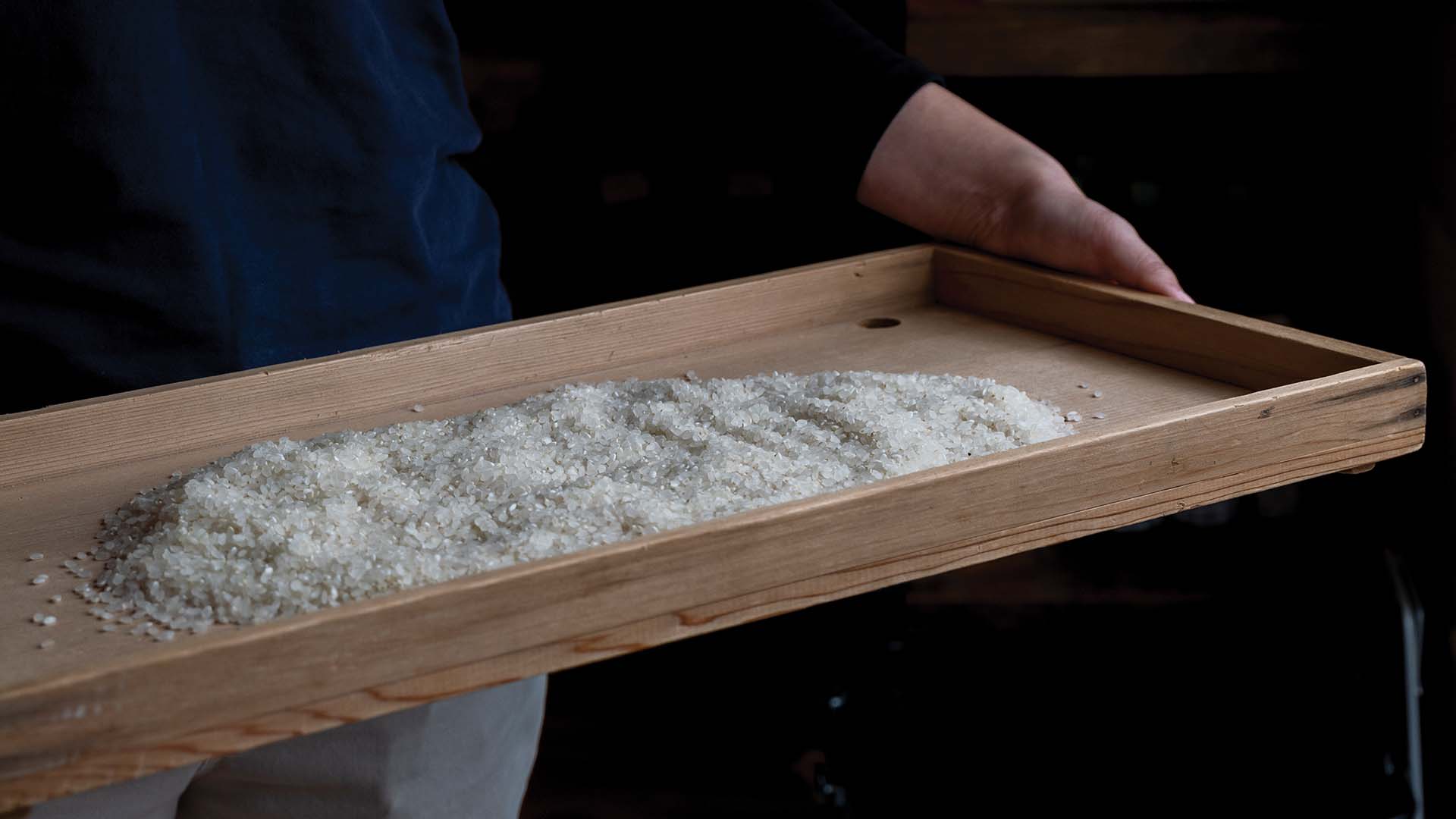Milled-to-order sushi rice, handmade mochi, and Hawai‘i’s only shochu brewery exemplify the Japanese ethic and craftsmanship around perennial staples.
Japanese artisans have crafted their foods in Hawaiʻi for over a hundred years. After arriving in 1885 to work on sugarcane and pineapple plantations their population quickly grew, many eventually opened businesses sharing the traditions, aesthetics, and expertise of their homeland.
High-quality is synonymous with Japan, but like anywhere else, advances in technology can sometimes reduce quality. Foods that are artisan made, generally meaning are handmade by the makers and purchased directly from them, may increase costs or be more challenging to source, but they are worth it. Here are three Japanese businesses on Oʻahu that produce small-batch, naturally-made products in the traditional way.
MOCHI
Nisshodo Candy Store
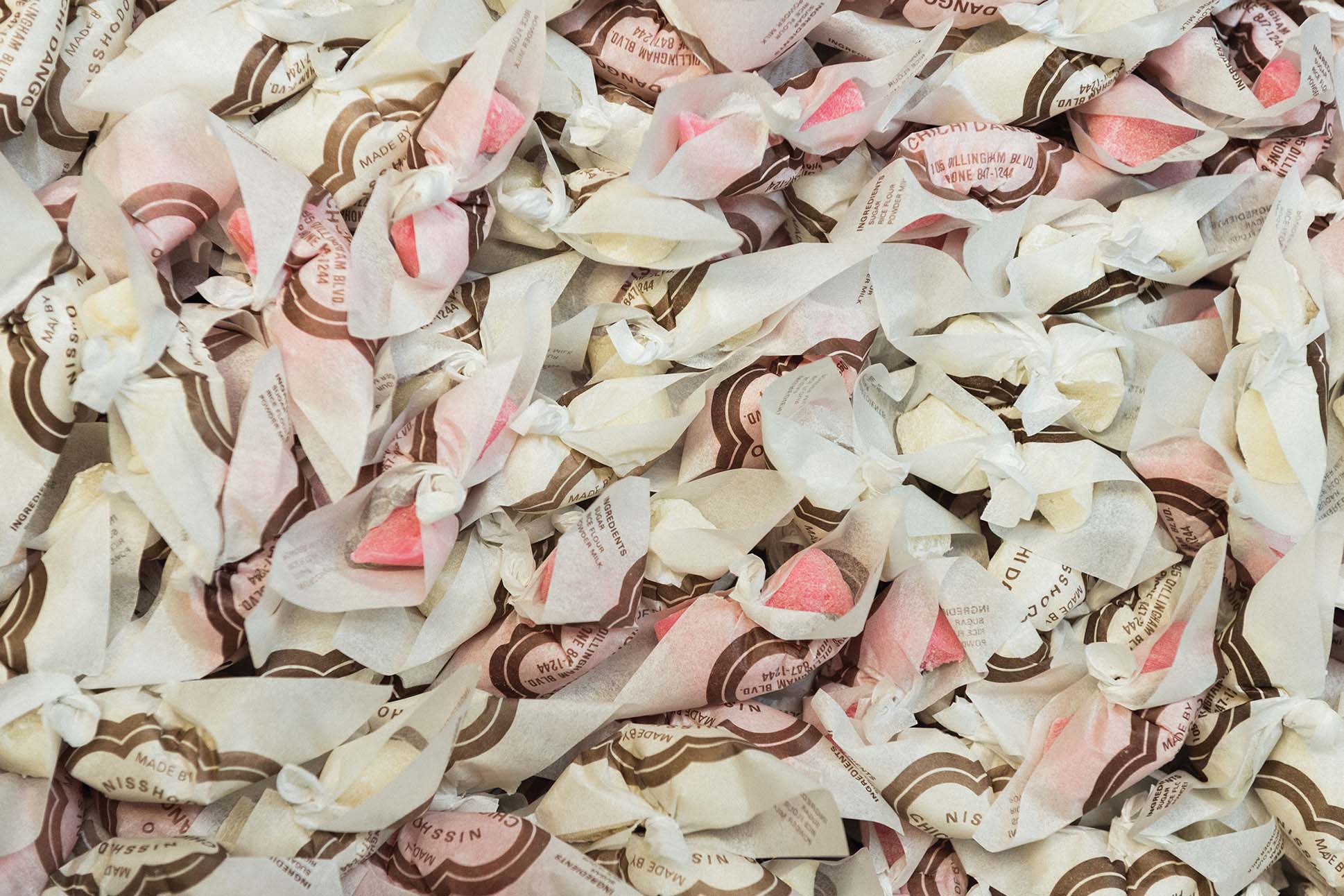
Mochi from Nisshodo Candy Store. Image by John Hook.
Asataro Hirao arrived to Oʻahu from Hiroshima, Japan in 1919. He and the men he traveled with worked on a sugarcane plantation for two years until Hirao, his mentor Mr. Tanaka, and his friend Mr. Baba left the fields to open Nisshodo Candy Store and make wagashi (Japanese confections). After a couple of years, the partners went their separate ways, but Hirao stayed put, hiring his family to make mochi together, per their Japanese tradition. Over one hundred years later, Hirao’s grandson Mike Hirao runs the show.
When Nisshodo first opened in 1921, neri ame, a sticky Japanese candy, was the most popular item. Today it is mochi and chi chi dango that customers come for. Mike and his crew pump out 1,000 pounds of their top-selling chi chi dango a week. Using mochiko flour from Koda Farms in California, they create pink dango (dumplings) wrapped individually in cushiony, bite-sized pieces.
Over the years, word has spread about the Hirao’s family recipes. Hirao says that many tourists now line up right alongside regulars at his hidden, industrial shop on Dillingham Boulevard.
Nisshodo mochi has the same texture and mild sweetness as chi chi dango, but is flavored and stuffed with a variety of ingredients such as green tea, peanut butter, anko (sweetened azuki beans), liliko‘i and lime.
Mike prefers making mochi with mochiko flour, sugar, and water in a standard mixer — a recipe he says comes out very smooth and silky and has a longer shelf life — to his former method that uses whole rice and a rice pounder, which he describes as more dangerous and labor intensive. When the dough is ready Mike spreads it out to cool slightly, and he and a few of his team members line the perimeter of a large table grabbing golf ball-sized portions of dough to roll and shape into plump, round pillows. Knowing when the mochi is ready to form takes skill. “If it’s too hot,” Mike says, “the outside will sag all over your hand and it will look pretty bad. There is a feel to it.”
Over the years, word has spread about the Hirao’s family recipes. Hirao says that many tourists now line up right alongside regulars at his hidden, industrial shop on Dillingham Boulevard. Since the mochi has no preservatives, he recommends freezing it in a Ziploc bag up to one week, taking it out as needed or keeping it no longer than two or three days, and storing it wrapped at room temperature.
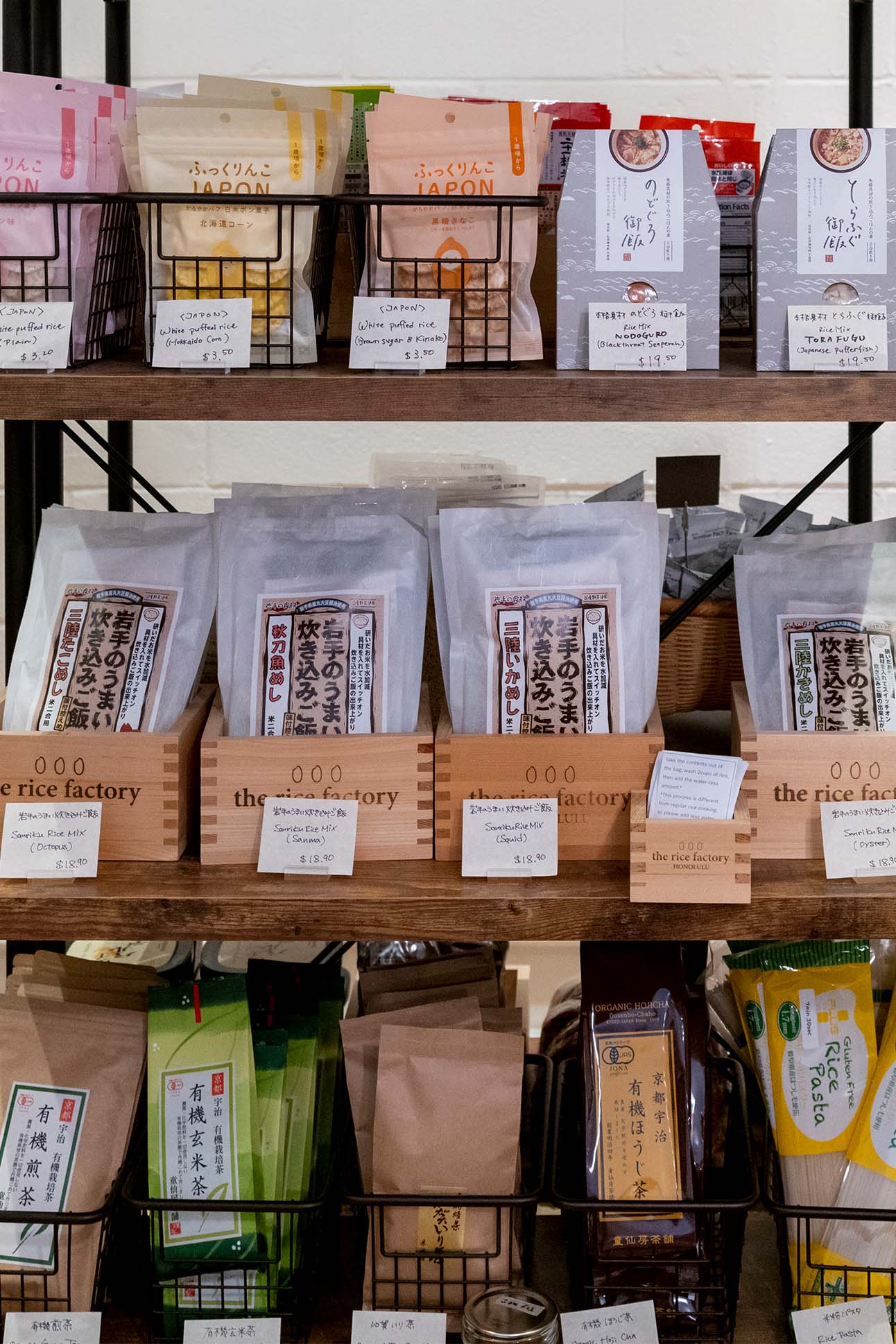

Left, The Rice Factory. Right, Hawai‘i Shochu Co. Images by Laura La Monaca.
RICE
The Rice Factory
Tomohiro Deguchi, owner of The Rice Factory, has an unwavering passion for tradition and quality. Living in Hong Kong he craved the taste of the rice grown from his upbringing in Japan. As a way to source this rice for himself and others he opened a store called Tawaraya in 2009. The concept proved so successful Deguchi continued opening stores under a new name, The Rice Factory. Throughout the 2010s, his establishments found homes in Singapore, Taiwan, Honolulu, and New York.
There are over 900 varieties of rice in Japan. Deguchi visited farms throughout the country to see their farming practices and source top varieties. As he earned the trust of the farmers, who were not yet set up for export, his line of rice varieties grew. The Kamiakiri variety, which was discovered by a Japanese farmer who found a rogue sprout in his field one day with a rice germ three times the size of the others, particularly intrigued him due to its high nutritional value and umami flavor. After begging the farmer for seeds Deguchi started his own rice farm in the Nagano Prefecture in 2017. Using natural farming methods sans fertilizers and pesticides he is one of only five farms in Japan to grow this variety, along with three other varieties: Hakucho Mochi, Sasashigure and Shirake Mochi. These are four of the eleven varieties available at Rice Factory Honolulu, all traceable to their source.
Crops are harvested in the fall and arrive fresh to the Kakaʻako store in early winter. Customers have the option of purchasing whole grain (brown) rice or having their rice milled to order at the shop. There are four milling options to choose from: 25, 50, 75 or 100 percent. Each percentage denotes how much of the husk, germ and bran will be removed. If a customer wants white rice, for example, they would specify 100 percent, meaning that only the starchy, white endosperm is left behind. This leaves the rice brimming with aromatic essential oils. It is so fresh it must be refrigerated to prevent spoilage. It is surprising to taste the real flavor of rice, a stark contrast to the usual filler at the bottom of your bowl.
Store manager Shiori Iida also stocks the store with other Japanese staples that Deguchi cherishes. This includes Yamaroku Shoyu aged in 100-year-old wooden barrels, Marukawa Miso that has been aged for 10 months, and rice vinegar made with eight times the amount of rice as commercial brands. Their inventory also includes housemade amazake, puffed rice, and mirin made with The Rice Factory’s Kamiakiri rice. “Japanese products have a lot of additives and it’s really tasty, but at the same time it’s easy to make a product that way,” Iida says. “We want to help protect the traditional way.”
SHOCHU
Hawai‘i Shochu Co.
Before moving to Oʻahu in 2013 to open Hawaiʻi Shochu Company, Ken Hirata apprenticed with a master of Imo-jochu (sweet potato shochu) in Kagoshima, Japan for four years. There, he learned every step of the process including the painstaking task of growing koji onto rice.
Next, he adds local sweet potatoes that he steams in a homemade wooden box and continues to ferment the mash another week or so until it turns vibrant magenta and bubbles like boiling porridge.
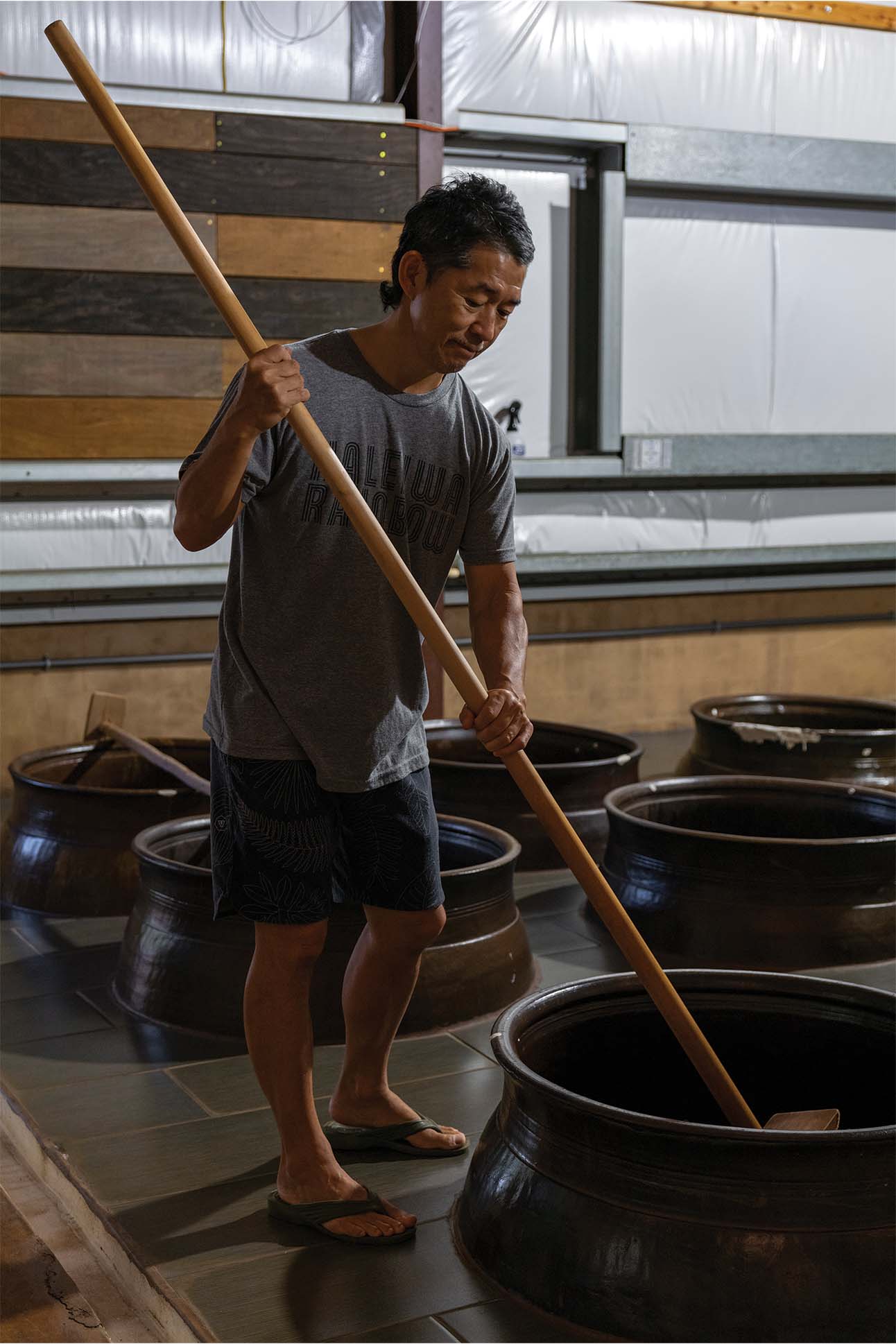
Image by Laura La Monaca.
Not to be confused with Korean soju, which is more vodka-like, Japanese shochu is a distilled spirit made with koji, a type of Japanese mold, highly revered for its health benefits and used to make miso, shoyu, and sake. In order to use koji, a shochu maker must first grow it onto a starchy medium such as barley or buckwheat. Hirata grows it on an heirloom variety of rice from Koda Farms in California called Kokuho Rose.
Afterward he ferments the koji rice in a 150-year-old clay pot, one of several his master from Japan gifted him. “Unfortunately, not so many people use these anymore,” Hirata says, “because they’ve been impressed by the nice big stainless steel tanks for mass production. But I think they do something magical compared to the other ones.”
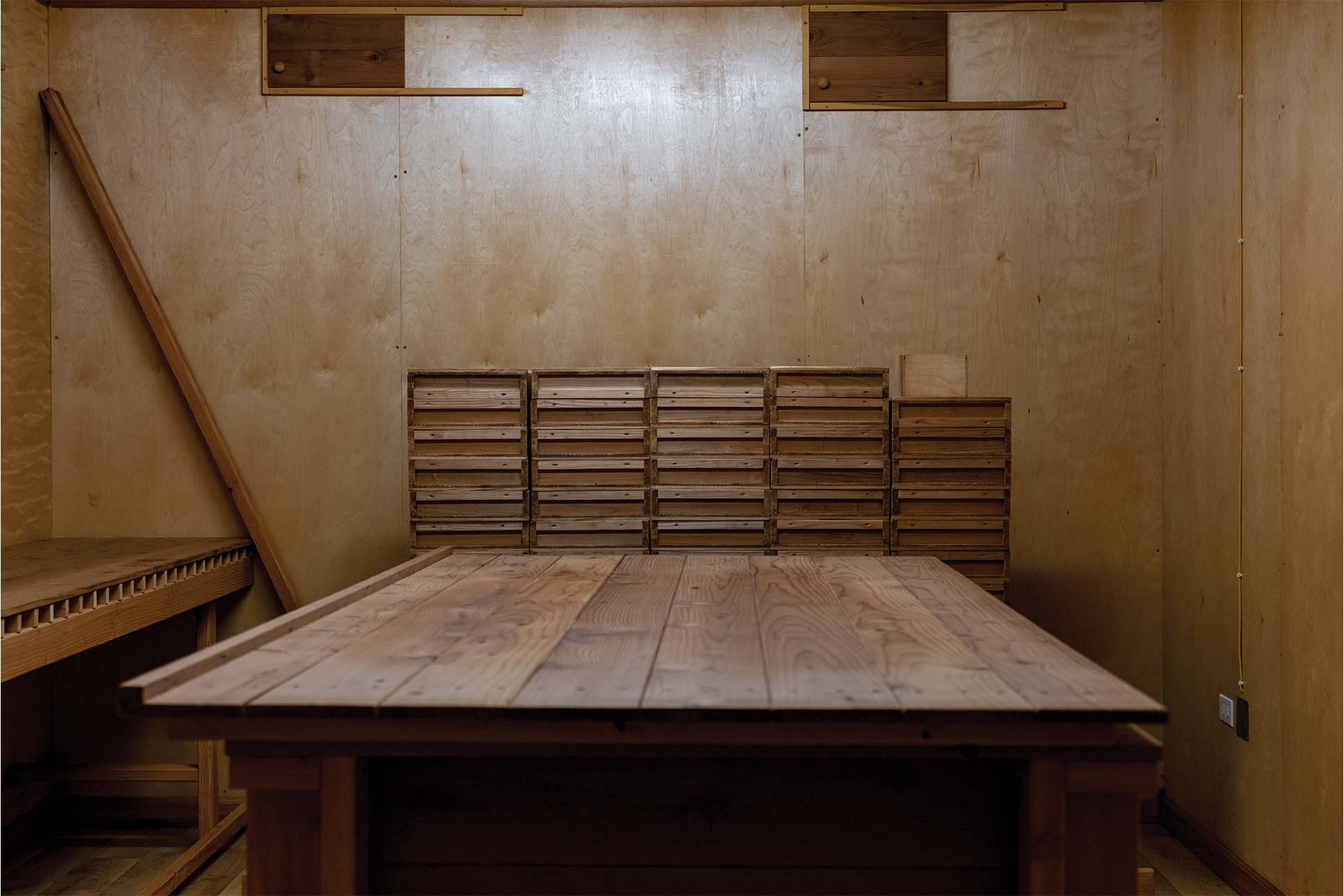
Image by Laura La Monaca.
Hirata uses a traditional Japanese wooden pot still for distillation, another piece of equipment no longer as popular in Japan. Every batch is different depending on which varieties of sweet potatoes and koji seeds that Hirata uses. Because sweet potatoes produce a different type of aroma compared to rice or barley, the aroma of Imo-jochu is very distinct. Hirata believes this is what people enjoy about it most.
In early 2023, he will release his twentieth batch of Nami Hana shochu, so exclusive that only a handful of O‘ahu restaurants serve it (customers who want to purchase a bottle can email Hawai‘i Shochu Co. and pick it up at his home). The thoughtfulness put into the shochu’s making is also reflected in its naming process: Nami Hana is named after the Japanese characters for “wave” and “flower,” which are, Hirata explains, “the two characters of the north shore.”

